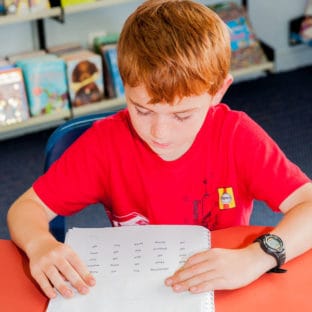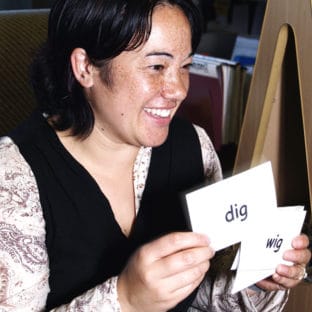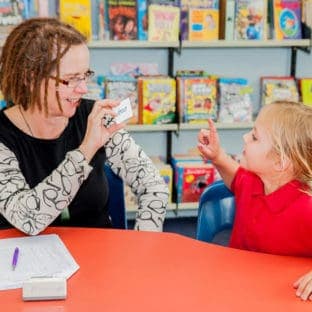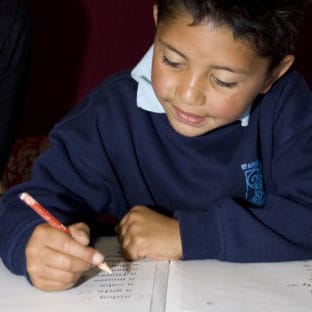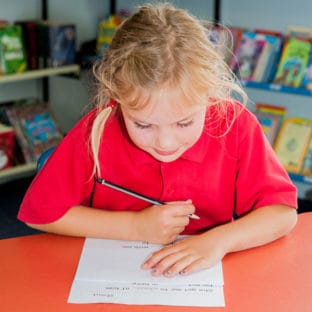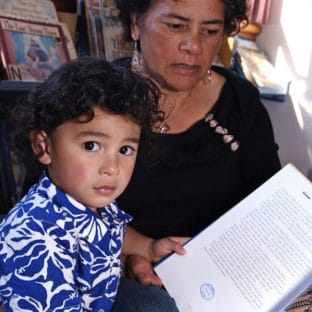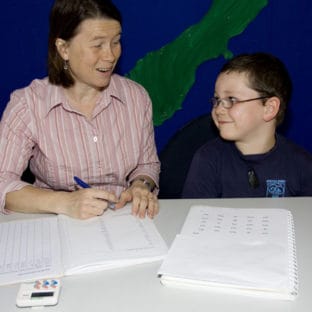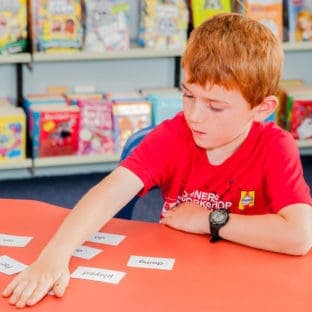Frequently asked questions
Accuracy
How can I help my pupil who is having trouble with distinguishing between am and my?
Some children do get stuck differentiating between two similar looking words. Try these ideas to help him differentiate.
1. As you are at ‘my’ focus heavily on this word and take ‘am’ out of the word pack and the probe (just cover it with a sticker and write a different word over it. Teach ‘my’ really well and in isolation from ‘am’ so when he looks at it, he is not thinking ‘am’. If he says ‘am’ when he looks at ‘my’, immediately say, “No, this is my’ and get him to say ‘my’ over and over again until he only says ‘my’ when he looks at it. You say and make him say ‘my’ in a strong voice to emphasise it and keep the focus on it. Get ‘my’ really strong in his memory with no mention of ‘am’. For eg, have 5 word cards with ‘my’ and 5 with an easier word such as ‘the’ and play some word games just with these two cards to reinforce ‘my’. Repeat, but change ‘the’ to another word. Make the lesson all about ‘my’ to ingrain it in his memory. If in the probe, even with ‘am’ taken out, he is still saying ‘am’, make a probe with just ‘my’ and one other word so he does not have to remember all the other words and can focus on ‘my’. Over teach ‘my’ until he always says it correctly when he sees it. Then bring back the full set of word cards, minus ‘am’, and the probe with lots of words on it (but not ‘am’). Work with these until he can do them all well with no mention of ‘am’.
2. Once ‘my’ is firmly in his head, bring ‘am’ back. Play games just using ‘am’ and ‘my’ cards so all he has to work on is these two words and how to differentiate them. Talk to him about how they differ visually and how he has to look carefully not to be tricked. Have the two cards face up on the table top and play slap where you say the word and he finds and slaps the card and says the word. Keep a tally and challenge him to get it right 10 times so he has an incentive to look carefully and differentiate between ‘my’ and ‘am. Make a probe for him with only these two words. Once he can tell the difference between the two words, then bring in the other cards and the normal ‘my’ probe so he is back on the programme as normal and continue from there.
It might take a bit of time but some brains do need a moment to pause and absorb what they have learnt and learn to look more carefully.
I have a pupil who makes lots of errors. How can I get him to look more carefully?
1. When teaching todays word, reduce the pack of cards down to just today’s word and one other that you know the child knows well so he is only having to compare the two words. Have three copies of each of the two word cards so he is not dealing with only two cards. Tell him you want him to read each word card correctly and work at a slower pace than usual so that he has time for careful monitoring. Once he can read the two words on the cards again and again without error, put in another previously taught word. Build up the number of word cards, one previously taught word at a time, only adding them back when each time he reads them all correctly.
2. Before the final probe, take an extra minute to practise reading it accurately, just working on one line only. Cover all but one line (any line) of the probe with a piece of paper and say to the child “I am going to read the probe as carefully as I can – watch me and tell me at the end if I made any errors ” and then read it correctly. Ask the child “Did I read that correctly?” Then say “Now it’s your turn to read a line correctly too.” Choose a different line for him to read, covering the rest of the probe with paper so he is only looking at that one line. After the child reads it, ask him “Did you read the line correctly?” and give feedback, praising if he made a mistake and self-corrected. You read another line and ask the child to check your reading as you do it in case you make an error. You read and the child monitors you. Occasionally put in an error to see if he notices. Then it is her turn to read a line. Ensure you do not read the same line as some children will just memorise it.
After 5 or so goes, then say “Now let’s do the whole probe and I want you to read it just as carefully as you did with reading only one line,” and end the lesson with the probe as normal.
If the child does not read accurately when reading the one line, cover the last two words of the line and model reading accurately just the first 3 words. Then it is the child’s turn with just three words in a different line. Once the child can do that accurately, move onto the whole line.
3. Praise for accurate reading: “You read everything right”, “I like how you are checking your reading so carefully”, “You’re great at getting each word correct”.
Some children get confused between words such as 'the' and 'here'. How can I help them?
For the child who is finding it hard to visually differentiate between ‘the’ and ‘here’ (and let’s face it – ‘here’ is always one of the harder words to learn anyway) make sure she knows ‘the’ really well first. Once she knows ‘the’ and always recognises it, tell her you are going to trick her and put in some other word cards to see if she can tell the difference. Do this frequently so she becomes used to monitoring her reading of ‘the’ very carefully. Once she can do this, when you come to teach ‘here’, repeat the process but do not put the ‘the’ in the pack of cards to compare it with until she can read ‘here’ no problem when mixed with other word cards. Once she has achieved that, then add ‘the’ and expect her to take some time to monitor but remind her she is able to read each of these words, she just needs to be a careful checker.
Is it ok to cover the visuals so the student has to read words and not use visuals?
Using the pictures to assist with reading the content words is an integral part of the programme. If a child was at the level required to read the content words without pictures, they would not actually need to be on the Early Words programme at all because they would be too good a reader to need it! It is also important to keep the pictures uncovered so that the student learns to use picture and context clues and this will be so helpful for them later when reading real books.Covering the pictures would also slow the reading down thus thwarting our aim of working for fluency.So, definitely do not cover the pictures. They are there for a reason.
What about children who forget a previously taught word?
If a child starts forgetting a word previously taught, check their score sheet for the word to be sure you didn’t move them onto to their next word without achieving accuracy and fluency. If you did move them too quickly, it is probable they did not have long enough on the word at the time of learning. Explain to the child that you need to go back to that word for a lesson or two to revise it and to make sure they have accuracy and fluency. When they do achieve this, go through each subsequent probe until the current one, ensuring they have accuracy and fluency on each one before checking the next probe. If they do not, stop and teach until they do. However, if your score sheet tells you that you did ensure the pupil had accuracy and fluency of the word before you moved them on, do not go back. Some children on learning a new word have to ‘lose’ a previously taught word in order to take on new learning. What you want to do is teach the child how to learn something new whilst retaining previously taught words. Explain to the child they are sometimes forgetting their old words, go through the word cards before bringing out todays word to remind them of what they know, and then proceed with the lesson as normal. When they forget a previously taught word, remind them ‘You know that word”. Tell them it if you have to and ask ‘do you remember it now?’ before giving the final probe, point out some of the previously taught words to remind the child that they know them before giving the probe as normal.
Fluency
My pupil is so slow with the reading during the lesson. How can I speed her up?
1. Before the final probe, take an extra minute in the lesson to practise reading it quickly, just working on one line only. Cover all but one line (any line) of the probe with a piece of paper and say to the child “I am going to read the probe as fast as I can – watch me” and then read it quickly to model to the child how you want it to be. Then say “Now it’s your turn to read the line as fast as you can.” After the child reads it, praise, then model reading it quickly again. Take turns reading the one line again and again, each time pushing for it to be read quicker than before and giving encouraging comments as the child reads – ‘That’s it, go fast” Go quick” You can do it”. You can time each line and jot the timing down so the child can try to beat their previous score and see instant progress.
With each line the child should get quicker. After 5 or so goes, then say “Now lets do the whole probe” and end the lesson with the probe as normal.
If the child does not speed up when reading the one line, cover the last two words of the line and model reading quickly just the first 3 words again and again, taking turns. Once the child can do that quickly, move onto the whole line.
Another tip, is to quietly read alongside the child when it is their turn so they have to ‘keep up’ with you. Read just slightly faster than them so it is achievable.
2. During the word card games, focus on speed. For eg, after reading the words on the ladder, ask the child to quickly just read the words again but faster. And again. Take any opportunity in the games to repeat the reading quickly. If the child can’t do this, you do it first as a model then ask the child to do it after you and try to be as fast.
3. At all times praise for speed and put urgency into your tone when encouraging during the speed activities.
Transfer
How can I help children transfer the word they learn in the Early Words lesson to their reading?
Make explicit the expectation of transfer at reading time. For e.g., after doing the book introduction, say to the child there is a word in the book that he knows. Show the word on the Early Words card (which he has had before in the Early Words lesson and so is familiar with it) and ask him to read it. Open the book at a page where the word is in the text. Ask him to look at the card and point to the same word in the book. Do this a few times with other pages, reminding him throughout that this is a word he knows. Have the card beside him when he starts the actual reading and if he does get stuck on the word, remind him that this is a word he knows and if he still doesn’t get it, ask him to read the word on the word card. Then ask him if the word he is stuck on in the book could be the same word? This is very explicit teaching of transfer but some children do not realise that the word they can read in one context is the same word in another setting. For these learners, explicit teaching of transfer from word to text level is required. I would also model this at Shared Reading so the children see you checking the word card with the word in the story and realising it is the same.
There are Early Words guided readers in the process of being published which means the child can immediately transfer the knowledge from the Early Words lesson to reading. Please contact us to be added to the email list for when they are published.
Management
My pupil doesn't like the word being written on her hand - I don't want her to be embarrassed in front of her peers but not sure what is the best way around it?
If she doesn’t want it written on her hand, I would go with that. You can always give her a word card to put in her pocket to look at when she has a quiet minute, or your pocket to ‘flash’ her when you see her (maybe do that not in front of the other children if that is the problem.) Or ask her if she is ok with writing it on the inside of her hand where no one can see. Let her guide you – the main thing is that she revises but that can be in any format that she is comfortable with.
Is it best to have two sets of the Early Words cards?
I usually do – 1 set for the child to take home and one for me to have to hand when she works with me. This is good in case she forgets to bring her cards to school or if we want to play match or snap.
Do you use doubles or triples of the word cards? e.g. have 2 or 3 of mum cards and 2 or 3 of the child’s name then eliminate the doubles later?
Yes, that is exactly what I do. In this way you are not just working with two cards and it is easier to play the card games.
Is it best to have two sets of the Early Words cards?
I usually do – 1 set for the child to take home and one for me to have to hand when she works with me. This is good in case she forgets to bring her cards to school or if we want to play match or snap.
Do you use doubles or triples of the word cards? e.g. have 2 or 3 of mum cards and 2 or 3 of the child's name then eliminate the doubles later?
Yes, that is exactly what I do. In this way you are not just working with two cards and it is easier to play the card games.
Special needs
Is Early Words suitable for a child with learning difficulties?
Early Words being a very structured sequential programme is usually very helpful for learners with difficulties. Progress might be very slow and stop start but over time you should be able to see the progression. Some adaptions of the lesson may be necessary (for e.g. giving longer to read the probe) so that the child can successfully participate in the lessons.
How do I adapt Early Words for a learner who cannot verbalise words clearly and who has problems writing?
I don’t think the fact your pupil cannot verbalise the initial sound of the word is a problem in terms of his reading if the approximation he gives for the word is always the same. For example if he consistently says ‘da’ for ‘the’ then he does know the word. If he can’t write the words in the writing worksheets, he can point at the word that needs to be written and you can write it for him. He checks you have done it right and then he reads the sentence as per the programme.
I have a student who has a slower learning process but at the same time is making slow and steady progress. Could you please tell me what an appropriate time would be for a slower learner.
For slower learners, these times can really vary and it all depends on the individual so I can’t give a set time sorry. What I can suggest is that if you do need to adjust the time, look at the lowest times he reaches when he does easy probes, and use those times as in indication of what the expectation should be for new probes to show he has achieved mastery. I wouldn’t change the error rate though.
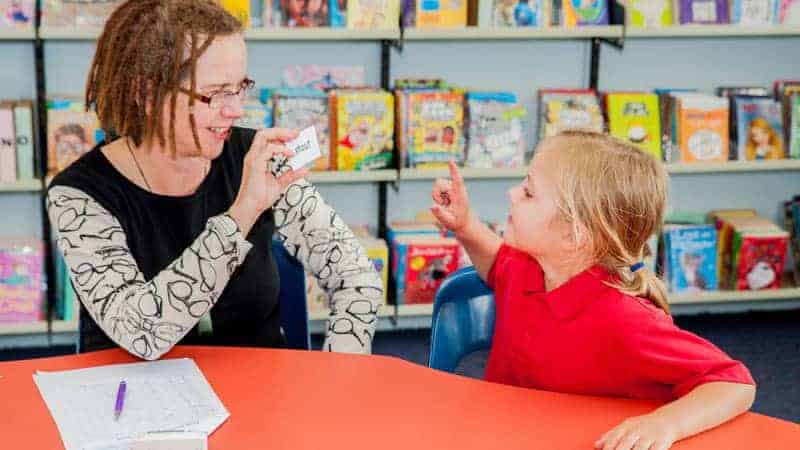
How quick is progress in Early Words?
Children vary in the rate at which they learn to read a new word. One learner may know it permanently within a minute or two of learning it and some will require repeated revision over a period of days or even weeks. Every learner is different. For children who find it hard to remember, increase the number of opportunities to revise.
Who needs Early Words?
Anyone at the beginning stage of learning to read may benefit from Early Words. Both children from four and a half years of age and adults have used the programme successfully to launch into literacy. Typical Early Words users are Junior School children, such as New Entrants, to give them a head start into literacy. Other users include low progress readers, learners with special needs and readers who can read the words but not fluently. Early Words has also been successfully taught by parents to many four and a half year olds prior to school entry to prepare them for reading success. Early Words can be particularly valuable for learners who are learning English as an additional language, whether as a child or an adult, because of the simple repetitive sentence structures and step by step progression.
What is different about Early Words?
Early Words combines teaching for accuracy and fluency. It is not enough that children can read the high frequency words. They must be able to read them easily and effortlessly. Children who pause to remember these basic words when they are reading read in a stilted fashion, impeding their comprehension and enjoyment of the story.
Early Words builds the fluency learning into the teaching of each word so that, as the children learn the new words, they also learn how to read them quickly as well as correctly.
Early Words also allows children to learn the words at both word and sentence level. Children see the word in isolation and then in text, so that they quickly see the usefulness of learning the words. After one lesson in the programme, a child can read a whole page of text. This is something very special for children who have never been able to read a page before and now suddenly can do so.
What is the first word a child should be able to read?
Their own name. A child can recognise their own name from two years of age if they are shown it enough and told what it is. If your child cannot read their own name, ensure you have it written in many useful places, such as their lunchbox, coat hook, and on their clothes and toys. Point to the word when you are using these items and tell them what it says. Ask them to point to it and read it after you. Do this regularly.
What is the best way to teach the high frequency words?
The word is taught firstly in isolation (out of text) as a visual pattern to be memorised. Then it is taught in a sentence. In this way the learner meets the word at both word and sentence/text level.
What is the order of words in Early Words?
The words do not follow other published word lists. Rather, they have been chosen in order of usefulness (i.e. which words are the most useful to teach first so that children can use them straight away in their reading).
Some useful words are further on in the programme than is ideal. This is because, in order to use these words in sentences, other words need to be known first.

